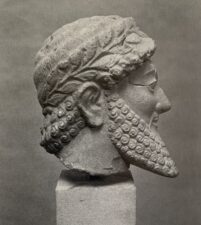
Unknown Roman
Cypriot
Archaic male head, 550-500 BCE
limestone
12 1/2 in.
SBMA, Gift of Wright S. Ludington
1978.4.1

side view
COMMENTS
Although this head conforms to stylistic traits that characterize male and female heads produced during the Archaic period of Greek art, such as almond-shaped eyes, “snail curls” in the beard and hair, and crisp delineation of the mouth, its origin is not Greece but Cyprus, which during the sixth and fifth centuries B.C. evidenced a strong synthesis of Cypriot and Greek elements in art. Now broken at the neck, the head must originally have belonged to a life-sized votive statue of a type common to Cypriot sculpture. Ordinarily, such limestone sculpture was richly painted, and the iris and pupil, not defined by incised lines, would have been painted in detail.
The workmanship of this head is commendable, particularly in the treatment of the tight, conventionalized curls of the beard and the ringlets that outline the forehead and the nape of the neck. The hair radiates downward from the crown of the head and falls in gentle registers of deeply incised wavy strands, which terminate in a double row of tight curls along the forehead and a triple row at the nape of the neck. The looser treatment of these ringlets of the hair and beard contrasts strikingly with the narrow moustache represented by carefully carved rows of small beads. The laurel wreath that encircles the head is simple in its outward form, but the individual leaves are subtly modeled.
Parallels to the Santa Barbara Cypriot head are not difficult to find. Two heads in the British Museum, perhaps slightly later in date than the Santa Barbara specimen to judge from the sharply ridged, rounder eyes, reveal close affinities? Two Cypriot heads in the Metropolitan Museum of Art in New York also offer convincing stylistic parallels?’ The strongest stylistic analogy may be seen in the head of a statue unearthed at Kition on Cyprus; the modeling of the eyes, ears, nose, and mouth on this head is strikingly similar to the modeling of the features on the Santa Barbara head? According to the stylistic-typological scheme established by Einar Gjerstad for Cypriot sculpture, the Santa Barbara bearded head falls quite suitably into the “second group of the Archaic Cypro-Greek style".
- Mario A. Del Chiaro, Classical Art at the Santa Barbara Museum of Art, Sculpture, 1984, p. 14
SBMA CURATORIAL LABELS
This impressive head was originally part of an over life-sized votive statue of a type common in archaic Cyprus. Votive statues were set up in religious sanctuaries as gifts to the god, and typically represented a person in festive garb, often holding out an additional gift. This mature male, who would have stood in formal role and mantle, wears a celebratory laurel wreath and has had his hair and beard stylishly groomed. All of these elements, as well as his eyes, would also have been painted in rich, bright colors. With its almond-shaped eyes, upturned mouth, and snail-curl ringlets of hair, this head could have been produced in Greece. It is a fine example of the rich cultural syntheses that marked the island of Cyprus in antiquity.
- Thayer Gallery, 2002
